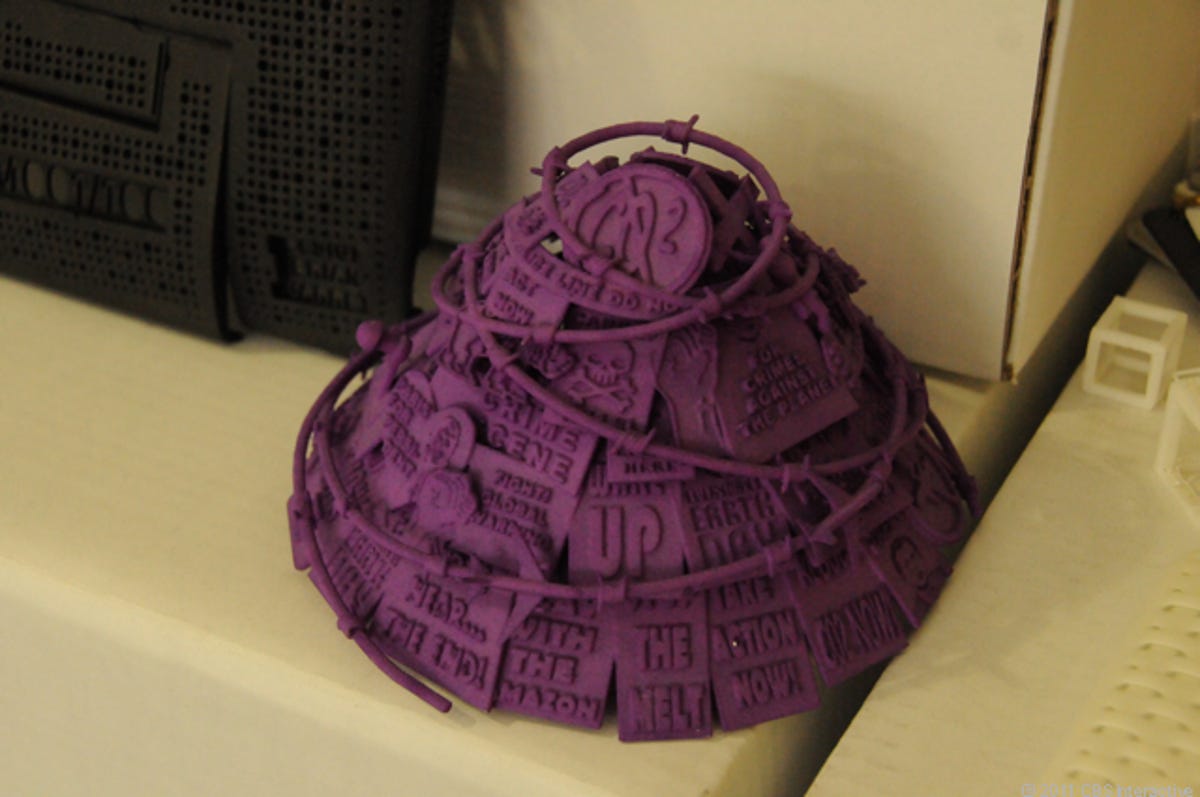3D like you've never seen it before (photos)
Road Trip 2011: Amsterdam's Freedom of Creation has built a business around beautiful, custom-made 3D products.

Purple lamp
AMSTERDAM, The Netherlands--In the consumer products industry, making things like lamps can often mean working with a Chinese or Taiwanese manufacturer, creating a mold, and turning out thousands and thousands of copies of the same item. Consumers get their lamp, hopefully at a decent price, but there is no room for customization, and design aesthetic is either not a consideration or raises the price considerably.
But here in this cosmopolitan Dutch city, a company called Freedom of Creation is on the vanguard of a movement to change the way things like lamps, handbags, iPhone and iPad cases, and countless other items are designed and made.
Rather than relying on traditional manufacturing methods, the company is a leader in the nascent 3D printed consumer items industry. That means that while FOC, as it is sometimes known, has a catalog of items you can buy, all have a very high design style, all can be customized in just about any way imaginable, and all-new products take just weeks from concept to delivery instead of months or years.
The reason is that 3D printing allows retailers to make a one-off, or a set of items, from any 3D digital file. No molds are necessary. All it takes is loading the file onto a computer, and letting one of the increasingly powerful and accurate 3D printers make the item. And because a 3D printer can make just about anything that can be designed, there are very few limits as to what can be created, and sold.
For example, look at this purple lamp, which is a material color test of another lamp that Freedom of Creation sells. The detail work on it is likely far beyond what could be done with mass production, yet its price, 400 euros, is probably only a little bit higher than what a much less detailed but high-design lamp would cost.
This lamp is made from a nylon material and was made using a 3D printing process called laser-sintering, in which a high-temperature laser is used to fuse materials together.
Stereolithography for Asics
At Freedom of Creation's Amsterdam office, there are countless examples of the company's work, many of which are tests and samples. Some are also items the company created for corporate clients. This item, which isn't for sale, was created for a shoe display for Asics, using copper-plated stereolithography. Note the many, many details in the piece.
Break packaging
Freedom of Creation also made this piece for Asics as part of a promotion. The item has printing on it that encourages someone finding it to break it open and find a puzzle piece inside. Each one of these items was slightly different, and all were made in their own individual 3D print job. All that was different between each job was that the digital file was manipulated a bit to change some of the details. The puzzle piece is loose inside the frame, something that can be done with 3D printing, but would be nearly, if not totally, impossible using traditional manufacturing methods.
iPad case
This is a Freedom of Creation iPad case made out of nylon using a laser-centering 3D printer from 3D Systems. It costs $127. Many of Freedom of Creation's designs have a signature printed on them of the person that created the item, as does this case.
iPhone case
Freedom of Creation is part owner of a separate company called Fresh Fiber that makes "fashion for electronics." It sells a variety of items like this iPhone case, which is available at Apple Stores for $41.
Dress
This dress features a complex design with interlocking chains of nylon-based links. It was a test piece done by Freedom of Creation, but it shows how 3D printing can be used to make items with elements like the interlocking chain that would be extremely difficult using normal production methods.
Handbag
This is a handbag featuring a handle made to look like brass knuckles. It's made from nylon using a laser-sintered 3D printer. It sells for around $429.
Fruit tray
3D printers are capable of making products using a wide variety of materials. This is a fruit tray made from sand on a laser-sintering 3D printer. Yet, despite being made from sand, it is quite strong and is made to last.
Aluminum
This item was made from a 3D printed wax cast that was then used as the basis for the final product, made from aluminum.
Headphones
The base shape for these headphones, which are a Freedom of Creation prototype, are made out of nylon using a laser-sintering 3D printer.
New bracelets
These bracelets are two of Freedom of Creation's newest products. They're made from three materials--glass, aluminum, and nylon. The laser-sintering 3D printer melts the nylon, which then binds all the materials together. The bracelets are sold for between $42 and $57 apiece.
Rings
This is a collection of rings designed by FOC, all done in nylon, and each costing around 27 euros.
3D printer
This is a consumer-level 3D printer sold by Freedom of Choice's new owner, 3D Systems. It can't produce objects as high-quality as the ones in the previous pictures, but it can make a lot of functional things. It is available for $1,850.

